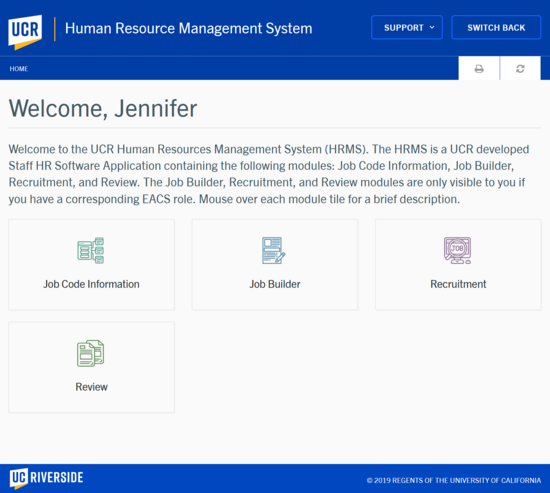
The University of California, Riverside Information Technology Solutions (ITS) team is proud to announce the development of Human Resources Management System (HRMS), a new multi-tenancy software built in conjunction with UCR Human Resources that effectively and seamlessly combines five existing human resources systems--iRecruit, iReview, CareerTracks, JDS, and Title & Pay Plan--into one portal.
HRMS is designed to centralize and streamline core human resources functions for more efficient and effective management. This translates to simplified training; synchronized, real-time data transfer; faster processing times; manageable maintenance; and the ability to scale up to meet future needs. The new HRMS software aims to improve HR task efficiency and data for HR, which in turn aims to improve the overall HR experience for new hires, hiring managers, and career staff.
“Before the deployment of HRMS in November of 2020, we received a large influx of support tickets regarding our old HR software,” said Disha Kibria, Project Owner and Associate Director of HR/APO Systems. “Since our launch, we have experienced 0 bugs in HRMS, effectively reducing our operational costs.”
Prior to the software’s development, human resources personnel were required to navigate through five different systems that appear, behave, and function differently from one another to manage HR processes, forcing users to learn and log into multiple applications to perform tasks. HRMS aims to eliminate this by combining the various legacy functions into modules in its software to provide a comprehensive HR management system.
Because HRMS was developed and coded uniformly following defined standards and guidelines, users benefit from a consistent user experience throughout each module; required fields banners, history, navigation tabs, and a routing bar are all features that are standard across every module. By implementing multiple modules into HRMS, the software provides a single point of access for all HR processes. Additionally, the scalable nature of HRMS allows ITS to continue to modify and add additional modules in the future, as needed, with a sixth module currently being developed.
The HRMS software has also effectively rid database links, or “middleman” links, by utilizing HR and operational data store application programming interfaces (API) to seamlessly integrate data between applications to directly view UCPath data. For example, users would experience a 48-hour delay when loading data on Human Resources Data Warehouse, a database link, whereas HRMS is able to effectively communicate directly with UCPath Reporting Instance data whenever data is requested.
Tracking progress and history are important functions within HRMS. Once information is migrated to HRMS, the software’s intelligence provides users with suggestions and reminders to ensure there are no duplicate entries when entering a user into the database. This makes future migrations more easily manageable, allowing ITS to decommission outdated software because there is no risk of losing important data.
“A feature I particularly like is the history feature which allows me to see who has viewed and approved the document already and where it is in the classification process,” said an HRMS user. “This lets us have one system of record to show who has touched a job description and how long they had it checked out.”
HRMS is multi-tenant, meaning the software can be leased to other organizations. This is an exciting opportunity for UC Riverside, as ITS has already received interest in the software from sister universities and UCOP.
To learn more about the system, please visit the University of California, Riverside Human Resources page.
